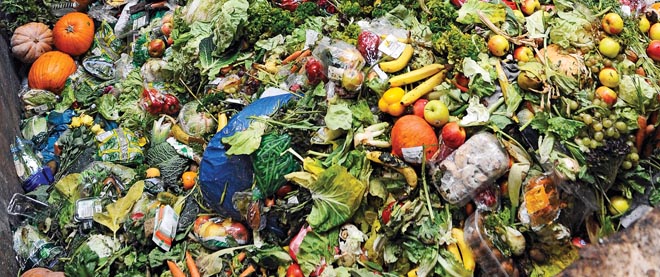By Makenna Laventure,
University of Saskatchewan Student
Food security

Food security is defined in terms of people having access to nutritious, safe food, that allows all individuals to maintain a healthy and active lifestyle. Many individuals are food insecure, especially those living in developing countries. The FAO estimates that in 2019 more than 820 million people did not have enough food to eat. In addition to this, the world population is only continuing to grow, which in turn is causing the demand for food to continue to rise. Counter to this food insecurity and concerns of food supply under a growing population, food waste is occurring throughout the food supply chain.
Food waste
Food waste occurs in different forms, one that is especially wasteful is when fresh produce that is deemed of lower quality or appearance is not sold into the food system. Food is being lost and wasted from the initial production stage up to the final household consumption stage. Multiple inputs such as water, energy and land that go into producing food are therefore being wasted along with final food products within households. One-third of the food produced globally for human consumption is lost or wasted annually. This is estimated to be approximately 1.3 billion tonnes of food. With the convenience of food today, people are not conscious of the fact that they are over purchasing food items. Over purchasing leads to excess food purchases eventually being discarded.
When it comes to food waste, we see it on the production and sales side too. Fresh produce, if not perfect in terms of shape, size or colour, it is usually removed from the supply chain during sorting operations to be discarded. There is also waste from ‘best before” dates being taken heavily into consideration by retailers and consumers and food products will be discarded when close to, at or beyond the stated date. “Best Before” dates are about quality rather than safety and once the date is passed it doesn’t necessarily mean the food is harmful, but it may have lost some flavour, texture, or peak freshness. Expiration dates, on the other hand, tell consumers the last day it is ideal to consume a product. In restaurants, an increase in portion sizes also contributes to the vast amount of food waste. Worldwide, food waste is a large portion of municipal solid waste, and the decomposing of food waste in landfills contributes to greenhouse gas emissions. This is due to anaerobic digestion and leachate production that occurs at landfill sites.
The world is producing extensive amounts of food. However, hunger is still one of the largest challenges faced in many parts of the world. With the rapidly evolving field of agriculture, feeding the world should not be a crisis. Being on opposite ends of the spectrum, food waste and hunger are two serious concerns. It is ironic, that the amount of food wasted is more than enough to feed hungry people worldwide.
Reducing Waste Throughout the Food Supply Chain
It will not be easy, but the reduction of food waste will have to start at the production stage and work its way down to the consumption stage. A few ways we could reduce the waste of food along the supply chain are:
- Producers: Proper storage facilities could be put in place as needed alongside paying closer attention to avoid spillage throughout the handling of crops, whether that be during harvest or throughout transportation.
- Processors: Working towards becoming more efficient with transport. Sourcing food from more local options so less transport is needed. Reducing the size of food items and providing retailers with the option to stock the items that would normally be discarded.
- Retailers: A reduction in portion sizes within restaurants and the amount of items stocked on shelves in retailers so items are not wasted and or able to be over purchased by consumers. Not only is this a solution for restaurants but also for food retailers, as in grocery and convenience stores. Along with this, normalizing the sales of non-perfect looking produce items. Finally, offering smaller inventory so less items end up as waste.
- Consumers: As a consumer yourself, you can start with small changes like planning ahead before purchasing food, smart shopping, composting and learning how to properly store food. Along with gaining knowledge on best before and expiry dates, you too can decrease your household food waste.
It will take time to see these small changes make an impact, but the world is not going to be able to continue overproducing and wasting food forever.
- Food and Agriculture Organization of the United Nations. Food Loss and Food Waste. 2019. Retrieved from http://www.fao.org/food-loss-and-food-waste/en/.
- Food and Agriculture Organization of the United Nations. The state of food security and nutrition in the world. 2019. Retrieved from http://www.fao.org/state-of-food-security-nutrition/en/
- Kubala, J. 20 Easy Ways to Reduce Your Food Waste. healthline. November 20, 2017. Retrieved from https://www.healthline.com/nutrition/reduce-food-waste
- Melikoglu, M., Sze Ki Lin, C., & Webb, C. Analysing global food waste problem: pinpointing the facts and estimating the energy content. Central European Journal of Engineering, February 19, 2013. Retrieved from https://link-springer- com.cyber.usask.ca/content/pdf/10.2478%2Fs13531-012-0058-5.pdf
- Municipal solid waste and greenhouse gases. Government of Canada. 2017. Retrieved from https://www.canada.ca/en/environment-climate-change/services/managing-reducing-waste/municipal-solid/greenhouse-gases.html
- Reducing Wasted Food At Home. EPA, August 2, 2018. Retrieved from https://www.epa.gov/recycle/reducing-wasted-food-home
- Sagan, A. Best before dates and expiry dates: 5 things you may not know. CBC. March 25, 2015. Retrieved from https://www.cbc.ca/news/health/best-before-dates-and-expiry-dates-5- things-you-may-not-know-1.3006858
- Taking stock: Reducing food loss and waste in Canada. Government of Canada. Retrieved from https://www.canada.ca/en/environment-climate-change/services/managing-reducing- waste/food-loss-waste/taking-stock.html#toc3
- What is Food Security?. Resilience, January 9, 2015. Retrieved from https://www.resilience.org/stories/2015-01-09/what-is-food-security/

Makenna Laventure
My name is Makenna Laventure, and I was born and raised on a farm in Northern Saskatchewan. I will be entering my third year of University come January 2020 and I am currently in my first year of Agribussiness.


Pingback: Impact of Global Food Waste on Food Security – SAIFood | plantlawyer
There are solutions to food waste which just need to be implemented or encouraged. Prairie Gleaners take off grade vegetables cut them up/ dehydrate them and make soup mixes which are sent to areas of need. I know of a bakery that donates all it’s day old bread, also there are several hotels that donate food that has not left the kitchen to feed the hungry organizations. There is a company that takes organic waste from supermarkets, composts the waste, mixes it with sulfur and sells it as fertilizer.
Pingback: Food Waste and Hunger Reveals a Startling Contrast - Malone Post